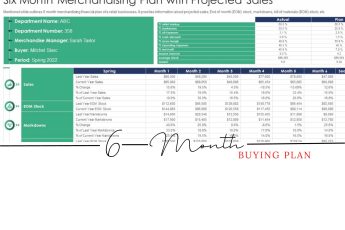Inventory planning is the process of forecasting, managing, and optimizing a business’s inventory levels to meet customer demand while minimizing costs and maximizing profits. It involves identifying what products to carry, how much to order, when to reorder, and where to store them. Effective inventory planning involves analyzing historical sales data, market trends, and supplier lead times to make informed decisions about inventory levels and ordering patterns. It is a critical aspect of supply chain management and helps businesses avoid stockouts, excess inventory, and other inventory-related issues.
How to Plan Inventory
When it comes to merchandising a store there is one component that has yet to be mentioned. Planning your store’s inventory. That is key to being able to plan your merchandising displays knowing what items you will be having in the store and how many at any given time. Being aware of your inventory also helps with store promotions and advertising.
How to Account for Floor Plan Inventory
Floor plan inventory accountability is crucial for the longevity of any business. By maintaining proper inventory counts and management allows for the store to maintain proper stock levels of top selling merchandise.
Now how do you account for floor plan inventory and what is floor plan inventory? Floor plan inventory is the merchandise you take on loan from a lender and intend to pay them back upon the selling of the higher priced items. The lender is taking the majority of the risk while it waits for the store to sell the items.
Accounting for floor plan inventory involves keeping track of inventory that is not owned by the retailer, but rather is on loan from a supplier or manufacturer. This inventory is typically used for display purposes, and the retailer does not own it until it is sold to a customer.
To account for floor plan inventory, retailers should:
- Keep accurate records: Retailers should keep detailed records of all floor plan inventory, including the quantity, value, and location of each item.
- Conduct regular audits: Regular audits can help ensure that all floor plan inventory is accounted for and that there are no discrepancies in the records.
- Monitor inventory levels: Retailers should monitor inventory levels regularly to ensure that they have enough inventory on hand to meet customer demand, but not so much that it becomes a financial burden.
- Communicate with suppliers: Retailers should communicate regularly with their suppliers to ensure that they have the latest information on inventory availability and delivery schedules.
By following these steps, retailers can effectively manage their floor plan inventory and ensure that they are maximizing their profits while maintaining positive relationships with their suppliers.
How to Develop an Inventory Plan
An inventory plan is the process of a business maintaining inventory counts and managing their merchandise. This helps with maintaining proper stock levels and replenishment schedules. This also allows the business to plan appropriately in terms of having proper funds available to purchase the replenishment merchandise.
Developing an inventory plan involves several steps, which are:
- Determine your inventory goals: The first step is to determine your inventory goals, which involves understanding your business requirements, sales projections, and customer demands. You need to decide the types of products you want to stock and the quantities of each item you need to order.
- Set inventory levels: Once you have set your inventory goals, you need to set inventory levels. This involves setting a minimum inventory level, a maximum inventory level, and a reorder point. The minimum inventory level is the minimum amount of inventory you need to have on hand at all times. The maximum inventory level is the maximum amount of inventory you can hold, while the reorder point is the inventory level at which you need to place an order.
- Determine lead times: You also need to determine the lead times for your inventory. Lead time is the time it takes from the moment you place an order to the moment you receive it. You need to factor in the time it takes to process the order, ship it, and receive it.
- Forecast demand: Forecasting demand is another crucial step in inventory planning. You need to analyze historical data, market trends, and sales forecasts to predict future demand. This will help you determine the quantities of each item you need to order.
- Analyze inventory performance: Regularly analyzing inventory performance is essential to ensure that your inventory plan is working as intended. You need to track key performance indicators such as inventory turnover, stockouts, and excess inventory.
- Adjust your inventory plan: Based on your analysis, you may need to adjust your inventory plan. For example, if you find that you have excess inventory of a particular product, you may need to adjust your reorder quantities or reduce the minimum inventory level.
By following these steps, you can develop an effective inventory plan that helps you meet customer demands while minimizing excess inventory and stockouts.
4 Types of Inventory:
Inventory refers to the goods and materials that a business holds for sale or use in production. There are different types of inventory that a business can have, and it is important to understand the distinctions between them. Here are the four main types of inventory:
- Raw Materials: Raw materials are the basic materials that a business uses to create its products. For example, a bakery would need flour, sugar, eggs, and butter as its raw materials. Raw materials are usually stored in a separate area from finished goods inventory.
- Work in Progress (WIP): Work in progress inventory refers to products that are in the process of being manufactured but are not yet finished. This type of inventory is often found in manufacturing environments where products go through multiple stages of production before they are completed.
- Finished Goods: Finished goods inventory is made up of products that are ready to be sold. This inventory includes products that are stored in a warehouse or on store shelves waiting to be purchased by customers.
- Maintenance, Repair, and Operating (MRO): MRO inventory refers to the materials and supplies that are necessary for a business to operate but are not directly involved in the production process. For example, office supplies like pens, paper, and staplers would be considered MRO inventory. This type of inventory is often managed separately from other inventory types.
Maintenance/Repair/Operation
Maintenance, Repair, and Operations (MRO) inventory refers to the stock of materials and supplies that businesses need to keep their operations running smoothly. This includes everything from office supplies to industrial equipment, tools, and spare parts. In essence, MRO inventory is the backbone of any organization, and without it, even the most basic tasks could become impossible to accomplish.
Maintaining MRO inventory can be a daunting task, as it often includes a vast number of items that need to be tracked, managed, and replenished on a regular basis. To help streamline the process, many businesses have turned to technology, such as inventory management software, to automate inventory control and minimize the risk of errors.
Here are some key steps for maintaining MRO inventory:
- Keep track of inventory levels: Implement a system to keep track of inventory levels and set minimum and maximum stock levels. This will help ensure that you always have the right amount of inventory on hand without overstocking.
- Conduct regular audits: Conduct regular audits of inventory to identify any discrepancies, damage, or obsolete items. This will help you keep your inventory up-to-date and reduce the risk of carrying too much obsolete inventory.
- Forecast demand: Forecast demand for MRO inventory by tracking usage patterns, maintenance schedules, and production schedules. This will help you plan ahead and order inventory in advance, reducing the risk of stockouts and downtime.
- Optimize storage: Optimize storage by organizing inventory by category, prioritizing items by frequency of use, and using storage solutions such as shelving, bins, and racks.
- Establish supplier relationships: Establish relationships with reliable suppliers and negotiate favorable terms to ensure that you have access to the inventory you need, when you need it.
By following these steps, businesses can optimize their MRO inventory management and keep their operations running smoothly. Effective MRO inventory management can also help businesses reduce costs, improve productivity, and minimize the risk of downtime due to equipment failure or stockouts.
Other terms related to this topic:
- How to plan inventory levels
- Inventory management
- How to develop an inventory plan
- Inventory management plan
- Inventory planning and control pdf
- Inventory planning methods
- Inventory planning models






